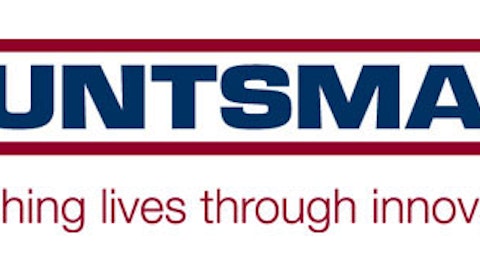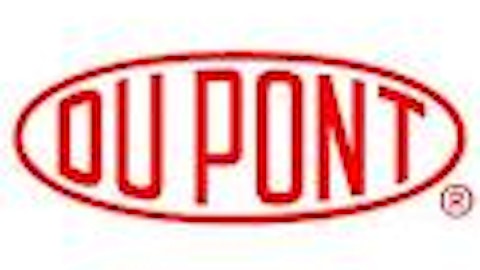
I don’t really blame Kronos’ management — The industry has been in a mess for months, and still is. The good news is that a turnaround might show its face this year. The bad news is that Kronos might remain a loser even then.
When lightning fell
It was among the worst quarters for the titanium dioxide (TiO2) pigment maker. Net sales were 9% lower year on year, and the profit of $85.8 million last year turned into a loss of $18.1 million. The reason for this? Kronos Worldwide, Inc. (NYSE:KRO)’ cost of sales surged 43% as input prices showed no signs of easing. Add 20% lower production, and Kronos had cooked up the perfect recipe for disaster.
Not being too harsh on Kronos, one shouldn’t forget that most peers turned up as shabbily in their respective last quarters. Despite having two other ailing businesses, Huntsman Corporation (NYSE:HUN)’s pigment division turned out to be its worst as revenue slipped 28% year on year on 17% lower volumes. Earnings before interest, tax, depreciation and amortization, or EBITDA, plunged 93%. Likewise, the performance chemicals division was the softest spot in E I Du Pont De Nemours And Co (NYSE:DD)’s fourth quarter, with a 15% drop in sales and a 54% slump in pre-tax operating earnings. Tronox Ltd (NYSE:TROX) also suffered a 21% drop in pigment division net sales.
The only difference was that each of these companies could still have ended with decent total revenue and net profit growth, unlike Kronos. That’s because each is diversified some way or the other. I think this is also what will work against Kronos Worldwide, Inc. (NYSE:KRO), even if TiO2 markets bounce back.
At complete loss
The problem is simple — Kronos lives on TiO2, which sadly isn’t a great business to be in presently. The same can be said of Tronox Ltd (NYSE:TROX), but its vertically integrated business model puts it on a different pedestal. The numbers above prove how raw material costs are hitting margins of TiO2 players more than anything else. Tronox procures titanium ore input in-house, and following a major acquisition last year, should start sourcing nearly 100% internally this year. Rio Tinto plc (ADR) (NYSE:RIO), which alone contributed 27% to global TiO2 sales in 2011, is also shifting focus from the pigment to feedstock production. While it recently dropped plans to set up a $4 billion TiO2 plant in Canada, Rio doubled its stake in Richards Bay Minerals (RBM) some months back. One of the top low-cost producers in the world, RBM accounted for 14% of global TiO2 feedstock sales in 2011.
Consultant-analyst company ICIS’ latest market report suggests that even if ore prices breathe a little easy over the next few months, they are likely to firm up in the latter half of the year. At the same time, with industry inventory levels still high, TiO2 prices will find it hard to come back. DuPont probably sees this coming, which is why it has projected 7% to 9% lower full-year margins for its TiO2 business. Worse, Commonwealth Bank predicts TiO2 prices to ‘fall sharply’ this year and next, followed by gradual decline from 2015 onwards. It expects a modest uptick in demand this year.
Tronox Ltd (NYSE:TROX) might make up on the input side, while DuPont has other resilient and high-margin businesses, like agriculture, to make up for lost ground. Rio has several other essential commodities up its sleeve to think about, and Huntsman Corporation (NYSE:HUN) has a strong and profitable polyurethanes business to bank on. For poor Kronos, it’s a total-loss game.
An avoidable risk?
Out of desperation, Kronos Worldwide, Inc. (NYSE:KRO) is willing to increase product prices, even as demand remains sluggish and stockpiles high. Huntsman Corporation (NYSE:HUN) also did it last month. It’s probably the slight improvement in sales volumes that these companies witnessed in their last quarters that prompted them to tread the danger line. But a low single-digit move up can hardly be termed as growth, and unless it sustains for a couple more quarters, it seems unwise to put already-low volumes at risk for want of better prices.
There’s clearly not much to be excited about for a Kronos investor. Management might want to instil confidence in investors’ minds with rampant insider activity, but Kronos is falling flat there as well.
When insiders don’t help
Insider trading is regular at Kronos, but has proved more of a lure-and-trap instance in recent times. Case in point: Kronos’ director Glenn R Simmons has been buying thousands of shares since January. His first purchase price on Jan. 17 averaged $19.18. The stock’s down about 15% since then.
The funny part is that not everyone on Kronos’ board is sure of what’s going on, or what to expect. Even as the Director built his portfolio, Chairman Harold C. Simmons disposed of 200,000 shares on Feb. 24 at $17.25, only to buy back half the number (in a non-open market transaction) at $16.75 on March 12. All investors can do meanwhile is sit and watch, or lick their wounds (if they had fallen for any of the insider buy calls, that is).
Even if you’d like to give a thought to the Chairman’s latest purchase, I’d prefer otherwise. The industry is simply not happening!
Stay away
Trading at under 9 times earnings with a handsome dividend yield of 3.6%, Kronos might appear tempting. Good if you love dividends, but not if you’re looking for some growth as well. Because try as you may, the fact that analysts expect Kronos to shrink a whopping 47% this year is too hard to ignore. More importantly, its peers might offer you more profits.
The article 1 Stock to Avoid in 2013 originally appeared on Fool.com and is written by Neha Chamaria.
Copyright © 1995 – 2013 The Motley Fool, LLC. All rights reserved. The Motley Fool has a disclosure policy.


